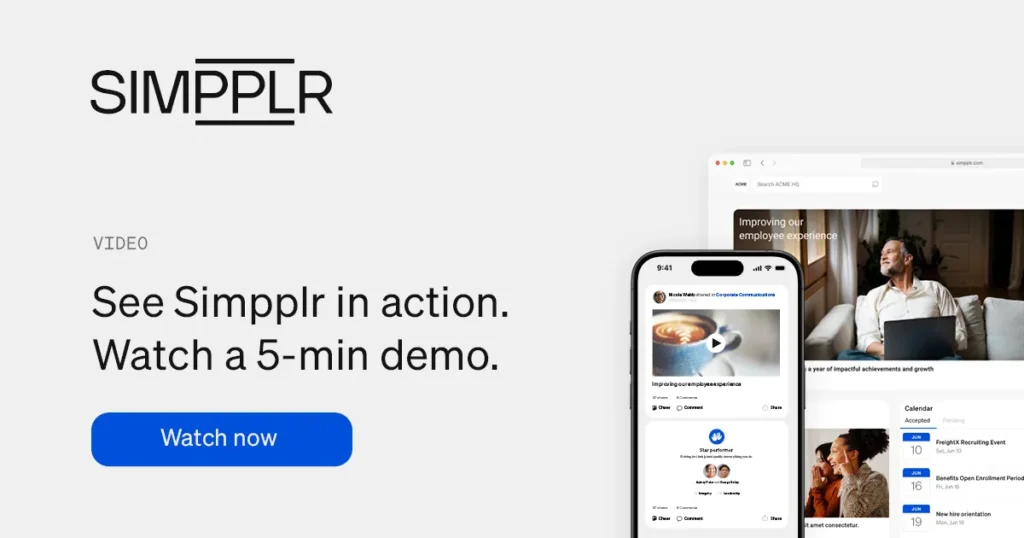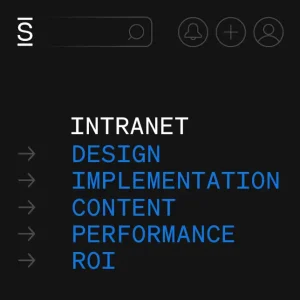Without proper governance, the intranet is beset with many problems that eventually kill the initiative: It becomes a content dumping ground, a sinkhole for the organization’s resources, and a significant cause for employee disengagement with the company mission and strategies.
Intranet governance is a set of controls guiding the use, maintenance, and growth of the internal communications system into a fully-fledged employee experience platform.
When you understand intranet governance, the importance of having a governance committee cannot be overstated.
Part 1: Poor Governance is the Top Reason Intranets Fail
Employee experience technology has taken great strides over the past two decades. Organizations no longer have to make-do with the clunky, static intranets of old. With access to advanced AI technology, they can rely on light, dynamic intranets that are more equipped to handle modern workplace needs.
Shockingly, intranets are still failing, and at an alarming rate – nine out of 10 by Gartner’s count. By understanding why intranets fail, Simpplr can offer a more advanced platform to our clients with every update. However, it turns out that the bigger part of the problem is on the client’s side.
Why do intranets fail?
In 2018, Simpplr Research conducted an exhaustive study on this very question. We wanted to find out the most pressing issues and challenges surrounding intranet adoption from the buyers and users themselves.
So, we pooled a sample of nearly 1,000 intranet practitioners, including IC and IT leaders, and asked a simple open-ended question: Why do intranets fail?
We got over 10 major reasons; primarily, respondents cited “poor intranet governance” as the leading cause of failure. Up to 57% of the practitioners who had experienced a failed intranet program faulted unclear ownership and governance – higher than any technical or functional issue.
Download our eBook: Top 10 Reasons Intranets Fail
What is intranet governance?
Intranet governance refers to the policies and administrative structure that guides the implementation and running of the employee experience platform. Governance allows your intranet to sustain ongoing meaningful internal communications, supporting decision-making and planning processes.
The organization must make deliberate investments to maintain an effective and successful intranet governance committee. Cross-functional coordination and leadership are a must. This means having each stakeholder contribute to the platform’s maintenance, monitoring, and continuous improvement.
The team must be inclusive of all aspects of the organization, including the various departments and locations. And there must be clearly defined roles and responsibilities for each member of the governance committee.
The first thing every governance committee should do
Through our interactions with intranet buyers and users, we have determined that many intranets fail because they don’t serve any purpose, i.e., their potential hasn’t been unlocked. Without a preset purpose, the intranet is deployed only to get pigeonholed as the source of lunch menus and happy hour photos.
According to the above-cited Simpplr Research study, one of the problems that failed intranets encountered was when they morphed into the ‘Frankenstein Intranets’.
“Our intranet serves different purposes depending on who’s using it.” That is the answer of a Frankenstein Intranet user.
It’s not uncommon for different stakeholders to view the intranet’s purpose differently.
- In one organization, the communications team views the intranet as a place to drive employee engagement. This creates pressure on the team members to encourage content consumption to justify this “purpose.”
- On its side, the IT team sees the intranet as a productivity enabler. So, they use it as a hub to connect different productivity apps, thinking this will validate the (expensive) decision to procure the platform.
- For HR, the intranet is crucial to improving the company culture by storing all the resources at a convenient location where employees can easily find them.
- Not very different from how other departments, such as compliance, see the intranet: A place to keep the policies and training material.
And so each embarks on ensuring their objectives are met.
This whole time, the employee is thinking, “I wonder what’s on the menu today!”
Granted, no single group above is wrong in its intentions with the company intranet. They all aim at a more efficient work environment. But they have turned tactics into core purposes of the intranet. In short, there is no set purpose, because there should only be one core purpose.
The first thing that every governance committee should do is establish that the intranet’s purpose is truly purposeful. What does it mean for an intranet to be purposeful? A purposeful intranet plays a crucial role in the success of your business.
You want a platform to help you endure various communication, knowledge, and collaboration stresses in the workplace: People are coming and going, budgets are being cut, people have personal lives that spill into the work environment, etc.
So, ask your team, “If our intranet goes away, is the business adversely affected?” If not, then its purpose wasn’t purposeful to begin with.
Part 2: Forming Your Governance Committee 101
It goes without saying, that to create a purposeful intranet, the governance committee must comprise the right people.
Having the right people on the governance committee is more about changing mindsets. This means harmonizing the perspectives of the different members and getting them to a point where they can objectively discuss the procurement and implementation of the intranet.
In many organizations, the governance committee comprises:
- Internal communications. This is typically the default owner of the intranet. Internal communications usually has the most evolved view of the intranet as an employee experience platform. However, when the purpose isn’t clear, IC adapts as in the above example, aiming to justify the intranet through improved employee engagement.
The communications role is often rolled up in Marketing or PR and may be successfully aligned elsewhere in HR, for example. However, organizations are increasingly creating a distinct Comms department, allowing more dedication to the role. For instance, Datto has the position of Digital Workplace & Intranet Manager, which has allowed it to reach 100% intranet adoption.
- Information technology. Rooted in the highly technical part of the intranet, IT may think that its role in the project is to configure the intranet. But we have shown elsewhere that most organizations prefer purpose-built intranets to IT-configured ones.
In modern click-operated (rather than code-based) intranets, there is virtually no technical need for the governance. The role of IT in the committee is to provide input into the project’s technical feasibility. The mindset of IT should be changed from overseer to user of the intranet.
- Human resources. This was the first owner of the intranet, but over time fewer intranets are being run out of the department. The role of HR in the governance committee is to represent the employee, making sure that the intranet addresses the human side of things.
Does it improve their transition into and within the company? Does it reduce frustrations? Does it protect them?
- The C-suite. It is a common mistake to leave out the executives when planning and implementing the intranet. Without active participation, the blessing from the CEO or other executive representative doesn’t count for much.
The CEO (or a representative) should be present at the table to see that the intranet aligns with the organization’s bigger picture: The mission, core objectives, and strategies.
Special cases may require more people on the governance committee, such as the legal/compliance teams in highly regulated industries.
Part 3: You have an intranet governance team—now what?
You have put the band together. Now it’s time to get them to play by first outlining the charter of the intranet, i.e., what outcomes are you trying to achieve? Remember, the first thing the governance committee will do is define the purpose of the intranet. Watch out for Part 7.
Next, set intermediary goals, success criteria, and measurements to solidify the charter further. After the implementation of the intranet, the governance team will be heavily involved with evaluating the progress, assessing adoption, reviewing feedback, developing roadmaps, and tracking milestones.
After that, assess and provide the technical requirements for implementing the intranet. Be different from many organizations that leave it to IT to gather the requirements and source the technology. Having a governance team means the procurement is decentralized, relieving any one department of the responsibility.
Then guide the implementation of the platform, signing off the deployment of features, sites, and content. With an excellent purpose-built intranet provider, you can create a fully customized platform to your organization’s needs: Fully functional, with no clutter, and no unnecessary features.
The governance committee will ensure freedom to create sites within the intranet doesn’t translate into a mesh of clutter and risks. Similarly, content governance will keep the workforce informed, engaged, and motivated.
Finally, the work is never over, as the committee has to commit to ongoing measurement, reporting, and improvement. Review what’s not/working, report back to the stakeholders on the program’s success, and apply insights gathered to the improvement of the platform.
Part 4: Managing a Federated Intranet with Multiple Managers and Content Contributors
In the past, intranets could only be managed through technical control. This made them stale, clunky, and ugly. It’s easy to imagine why: An unwieldy platform was created and left in the hands of an organization with few resources to spare. Of course, it went out of control.
The modern intranet is within reach for many organizations. Technological advances have made it easy to install the platform, use it to collect valuable usage data, and updates can go at the speed of business. As a result, it is now possible to spread the benefits, responsibilities, and accountability of the intranet across multiple owners.
This is referred to as the federated ownership model, where the different parts of the application are owned and controlled by different owners. An organization’s governance committee might decide to leave the overall administration to a central IC manager but allow various sites to be autonomously maintained across the organization.
Recalling the Frankenstein Intranet effect, it might seem difficult, but managing a federated intranet with multiple managers and content contributors isn’t as complicated as it sounds. What it requires is a structure dividing up sites by different criteria as it seems fit.
By department
Different departments, such as IT and Marketing, may want to create their own sites. As discussed in Part 2, it is crucial for all departments to get a seat at the governance committee table to prevent alienating some parts of the organization.
Each member should be keen on what the platform offers their department without straying from the core purpose. The head of the department should serve as an intranet site manager or work closely with someone on their team to administer.
By location
Many large organizations have their workforce distributed across different locations. While the intranet does a great job of unifying communications, it may still be necessary to sort the sites by location if much of the content is location-specific.
On location-specific sites, you can promote location-based content such as events, employee benefits, and compliance documents, among others.
By process
Various company workflows may be improved with dedicated sites. A classic example of this is the new hire onboarding site, where new employees can be taken to see essential resources during onboarding, such as instructional videos and setup checklists.
By affinity groups
Employees with the same interests or backgrounds may already be connected through affinity groups. Examples include jogging clubs, reading circles, and LGBTQIA+ allies. With the capabilities of the intranet, they can organize themselves better with dedicated sites.
Typically, an employee with interest in a given area is allowed to set up the site and run it. We recommend strict monitoring of the sites, at least initially, to prevent them from getting out of control.
While decentralizing intranet ownership has many benefits, organizations must take special care in governing and managing the distributed sites. The governance committee should sign off on the addition of new sites based on the stipulations of the charter.
Many intranets fail because they become content dumping grounds, but with joint responsibility and accountability, the platform order can be maintained. The governance committee shouldn’t be tasked with day-to-day supervision. That’s the responsibility of the account managers.
To ensure smooth running, it would help to sit down with the site owners regularly (e.g., every quarter) to review the performance and set action plans to improve the site.
Part 5: How your governance committee aligns with intranet content management responsibilities
The success of an employee experience platform is highly dependent on the content staying fresh and engaging. With all the business functions represented in the governance committee, beating the drum is shared as they all contribute to content management.
Typically, IC assumes the editorial role, building a content roadmap and being the custodian of the content calendar. Beyond that, each function can add to the intranet with all kinds of engaging content. Below are some ideas to inspire you:
IC can improve intranet content through…
- company-wide weekly updates,
- community-building fun activities,
- intranet newsletter summaries,
- all-hands meeting schedules,
- all-hands meeting summaries, recordings, and follow-ups,
- updates to content engagement hooks (e.g., lunch menus, train schedules, facility updates), and
- engagement surveys.
The office of the CEO can share…
- company vision,
- company history,
- company mission,
- organizational roadmaps,
- progress updates on company projects, new partnerships, etc.
- board meeting and earnings call recaps,
- monthly check-in on company goals and metrics,
- customer letters, testimonials, spotlights,
- department spotlights,
- company values,
- industry perspective and/or competitor news,
- employee recognition,
- philanthropic efforts,
- personality content, and
- inspiration.
IT has a lot of content to share regarding…
- software adoption, e.g., promoting the use of new productivity tools,
- critical security news, e.g., emerging scams, security policy reminders, etc.
- how-to’s, e.g., self-help configuration steps, login procedures, and setup steps, and
- ticketing system FAQs, e.g., how to submit tickets and common requests.
Marketing and sales have…
- message and content positioning briefs,
- campaign overviews,
- new product launches,
- new customer successes,
- the strategic rationale behind various actions such as press releases,
- marketing events calendars,
- industry trends and competitive updates,
- new resources, e.g., whitepapers, brochures, etc., and
- customer case studies.
Human resources can share…
- employee spotlights,
- job openings,
- new hire onboarding,
- benefits updates and deadlines, and
- workplace policy changes.
Creating an intranet content roadmap shouldn’t be daunting with all these potential inputs from the different stakeholders. The key is for the organization to be disciplined enough to create an intranet editorial calendar and implement it. IC typically leads this with a review and sign-off from the governance committee.
IC may also want to coach people on creating intranet content for maximum employee engagement and participation: Language, tone, voice, length, relevancy, etc.
Part 6: Roles and responsibilities for internal communications
IC should be more involved with content aggregation than creation. In organizations with a failed intranet, it’s the other way around: The organization relies solely on IC to produce its content. This leads to a gatekeeper situation where IC needs to spearhead every decision instead of the preferable gardener approach, aiming to cultivate growth in others.
Internal communications and intranet roles and responsibilities
In summary, this is what IC should be doing:
- Monitoring progress toward the intranet’s charter and goals through measurement and study.
- Sorting out communications to ensure people get only the most relevant content, which improves employee engagement.
- Establishing and enforcing content creation and distribution standards.
- Tracking activity against the content calendar to keep contributors accountable.
- Working with site administrators to review site analytics for insights on optimizing content delivery.
- Monitoring the overall intranet roadmap to keep the platform at peak performance.
- Promoting the adoption of the intranet among the employees by constantly sharing its purpose, enabling the workforce in various ways, and demonstrating its application across the organization.
- Tracking emerging issues and communicating them to the governance committee.
- Gathering employee feedback on intranet use to know what works and what needs improving.
- Providing support and training on how to get the most out of the platform.
- Handling vital information (e.g., ghostwriting for the CEO) to ensure strategic internal communications are aligned and current.
- Like a good gardener, pruning unnecessary and counteractive material.
And now a little bit about what IC shouldn’t be doing but is unfortunately what’s happening in many organizations:
- Creating content in a vacuum for the sake of getting new stuff out there.
- Micromanaging content production and distribution.
- Spending any amount of time on technical issues.
- Signing off on new content and sites without proper review and consideration.
- Creating content for other departments.
Assessing IC by looking at intranet management can help bring to light its adoption and chances of success. It can also tell you how effective the governance committee really is because when IC lacks broader organizational support, it’s forced to band-aid the process.
Part 7: The importance of your intranet’s goals and charter
Following the Why Intranets Fail study in 2018, Simpplr Research reported on the State of Intranet 2019, which reveals some startling statistics. Among the respondents working with active intranet programs, 57% said they didn’t have articulated goals, while 23% said they have a charter, but not everyone follows it.
Your intranet should have clear goals and a charter that everyone understands, follows, and aligns with. The good news is that after failing, many organizations are willing to try again, applying what they have learned with previous intranets.
Alongside having the wrong purpose and creating the Frankenstein Intranet, organizations have realized that their systems also fail because they followed bad advice or used ambiguous language in goal setting.
Some will tell you that the intranet has “five key purposes” instead of one core purpose. They say it delivers content, is a crucial communication tool, enables collaboration, supports culture, and creates efficiencies by supporting business activities.
This is the wrong advice.
First, saying the purpose of the intranet is to deliver content, be a key communication tool, and enable collaboration effectively renders it useless as we already have tools such as chat apps and email for that. Second, all five are tactics and not the desired outcome that ties everything together.
A common trend is to tie the intranet’s charter to focus on employee engagement, culture, and connecting distributed workforces. On the surface, this seems like sound thinking aimed at tackling pressing business issues.
However, these goals are not only difficult to measure and make a business case around, but it is also hard to understand what “increase employee engagement” and “improve company culture” mean. Different people may interpret culture and engagement differently.
The following is an example of a good purpose statement from a Simpplr customer: The intranet is part of a broader employee communications strategy where we will strive to (a) connect employees that don’t naturally interact and (b) better align employees on strategy, values, purpose, and focus for every employee to be on the same page. So [our] employees are less likely to leave and more focused and excited about work.
The language is unambiguous, they have separated tactics from outcomes, and the tactics themselves were only two, not five. The customer is also very clear about how success will be measured continually. It uses eNPS and voluntary turnover benchmarks to understand the success of the employee communications strategy.
Part 8: Executive engagement makes or breaks your intranet
To ensure success with your intranet, you need more than a nod from the CEO. In Why Intranets Fail, 24% of the respondents said lack of executive involvement was a primary cause of intranet failure. While most CEOs know the benefits of having an engaged workforce, many need to be more active to achieve internal alignment.
For instance, in more than 65% of organizations, the leadership shares the vision and strategy quarterly or less frequently. You want to touch base four times a year to engage and align your workforce? Not going to happen!
An employee experience platform can be an essential tool to help align the workforce, steer the culture in the right direction, and reinforce company values. But executive engagement, not mere blessing, is critical to success.
If you’re struggling to convince your CEO to get involved, look at things from their perspective – understand the big picture – and show how the intranet fits into that. They have probably seen it before: An intranet that doesn’t provide concrete business ROI.
Now is the time to prove that this time it’s different. Rather than coming with hard numbers (which you might not have anyway), articulate the platform’s benefits and provide some employee data to support your argument. For instance, tell them how employees want to consume leadership information. Your research will prove that they want it to be more regular, timely, short, useful, relevant, interesting, unique, clear, and inspiring.
Finally, make it easy to get executive buy-in. Most executives aren’t communications experts and they probably have too much on their plate to take on more. Once you’ve shown the intranet’s place in the big picture, explain that you will provide a roadmap and playbook on what to do.
Conclusion
The intranet has many gears that may grind if poorly aligned and greased. In a nutshell, an intranet governance committee ensures that the platform’s full benefits are realized.
These intranet governance best practices have been developed after extensive study by Simpplr Research, interviewing our customers and intranet practitioners to reveal what makes a successful intranet governance committee.
Start applying them now by putting a strong team in charge of your employee experience platform and working together to get company-wide involvement. Reach out for a demo to see how Simpplr can help you achieve the purpose of your intranet.


















